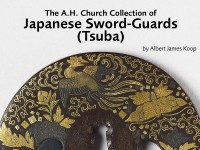The A. H. Church Collection of Japanese Sword-Guards (Tsuba)
An unpublished catalogue of the A. H. Church collection of Japanese sword-guards (tsuba) by Albert James Koop.

The term “Shingen” is given to two peculiar forms of decoration consisting of brass, iron or copper wires more or less loosey applied to the iron forming the ground or core of the guard (not fixed by brazing as with Gomoku work). The name is sometimes extended to the Mukade work dealt with in the last Group.
In one form, which may be called the Wire-bundle Type, the guard is overlaid with symmetrically disposed bundles of wires, single or stranded, which are lashed down by other wires threaded through holes pierced through the guard. Sometimes the actual body of the guard is completly covered by the wiring and often a guard of Akasaka type with geometrical openwork is used for the purpose.
In another form, the Mat-weaving Type, a frank imitation of the woven mats used as kettle-stands at the Tea Ceremony is laid over either face of the circular iron plate, a brass rim holding all in place.
Shingen Guards are supposed to date from the time of Takeda Shingen, the great territorial lord (about 1560), who is said to have encouraged their manufacture; but they did not become generally fashionable until the 18th century.
Notice
Object information may not accurately reflect the actual contents of the original publication, since our online objects contain current information held in our collections database. Click on 'buy this publication' to purchase printed versions of our online publications, where available, or contact the Jameel Study Centre to arrange access to books on our collections that are now out of print.
© 2013 University of Oxford - Ashmolean Museum


